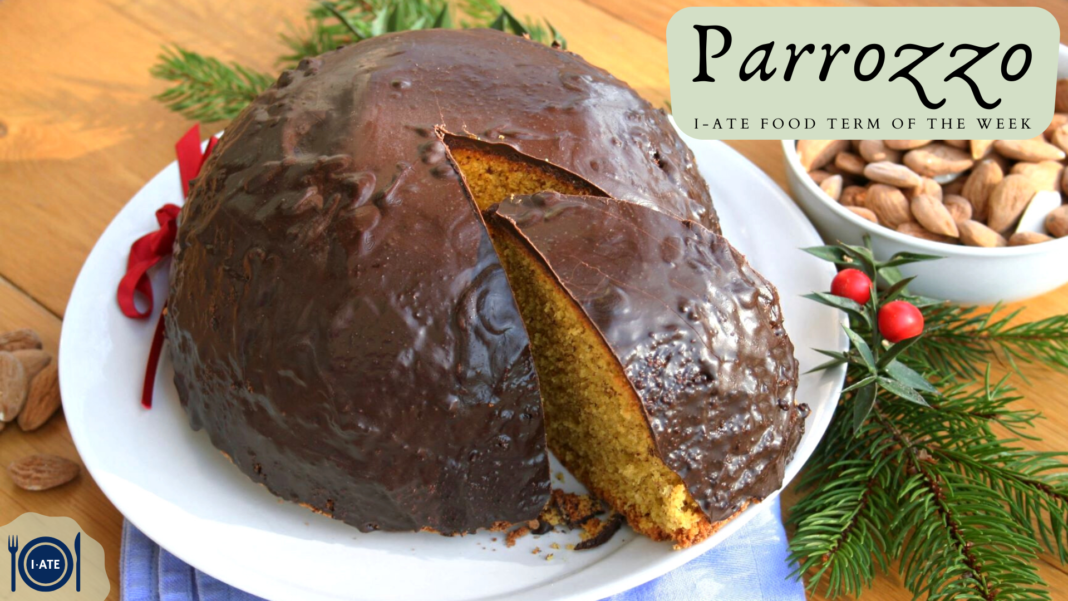Parrozzo is a traditional Christmas cake from the city of Pescara, in Abruzzo (a region of central Italy), officially recognised as a traditional food product. Dome-shaped, it is composed mainly of semolina and almonds, and entirely covered with melted dark chocolate. The consistency is that of a moist cake, with an intense flavour given by the presence of liqueur in the mixture.

Parrozzo is a dessert of contrasts: dark outside, light inside, tough and soft at the same time, somewhat like the people from Abruzzo.
Its recipe was conceived and developed around 1920 by Luigi d’Amico, a pastry chef from Pescara. D’Amico had the idea of making a cake resembling the ancient rustic bread of the Abruzzo peasants, called “pane rozzo” / “rough bread” (from which the name parrozzo is derived), which was a dark loaf meant to be preserved for many days. It was made from the less-valuable corn flour, and then baked in a wood-burning oven.
D’Amico gave the parrozzo the same semi-spherical shape as the bread. He then worked a mixture of egg yolks and finely crushed almonds to reproduce the yellow colour of corn and the roughness of the bread; finally, to give it the typical burnt appearance of wood baking, he covered the cake with a rich dark chocolate glaze.
The first person to try the new delicacy was the confectioner’s friend, poet and fellow citizen Gabriele d’Annunzio, who was immediately enraptured by the cake, and composed a madrigal called “La Canzone del Parrozzo” (“The Song of Parrozzo”), written in local dialect. It was 1926 when d’Annunzio sent this lyric to Luigi D’Amico, to thank him for the gift of the parrozzo and to glorify the latter as “the sweetest of all sweet things”.
D’Annunzio also went on to refer to parrozzo in several of his works. In 1927, paraphrasing a quatrain by Dante Alighieri (Inferno XXVIII, 17-18), the Vate renamed it usbergo (armour), asserting that in the famous battle of Tagliacozzo between Guelphs and Ghibellines, Conradin would have defeated the gluttonous Alardo (Erard of Valery) if he had protected himself with the parrozzo, since the Angevin would not have dared to hit him: “Dice Dante che là da Tagliacozzo, ove senz’arme visse il vecchio Alardo, Curradino avrie vinto quel leccardo se abbuto avesse usbergo di Parrozzo” (“Dante says that there at Tagliacozzo/ where unarmed old Alardo won/ Corradino would have won/ if he had a hauberk of parrozzo”). All this too is contained in a parrozzo.

These verses still appear on the hexagonal packaging that characterizes the precious cake, designed and coloured by Pescara-born ceramist Armando Cermignani, a reminder of the noble origins of the literary Parrozzo. The idea was successful and d’Annunzio contributed, as he had previously done with other products, to increasing its fame. The parrozzo appeared on the tables of artists, men of letters, politicians, and even the Pope, all won over by its deliciousness.
Nowadays, the parrozzo is also produced industrially by the company founded by its creator, so that it can be enjoyed throughout the year, even in mono-portions called parrozzini (small parrozzi). As d’Annunzio further wrote, “the first slice is still for appetite, the second for delight, the third for voluptuousness”. Beware of the fourth!
If you liked this article, you may also like the one of Panettone.
REFERENCIES AND RECIPES:
La cucina italiana. 2020. Christmas Parrozzo. Available at: https://www.lacucinaitaliana.com/recipe/cakes-and-desserts/christmas-parrozzo. [Accessed 20 January 2022].
La cucina italiana. 2020. Ferratelle and Parrozzo: Traditional Christmas Sweets in Abruzzo. Available at: https://www.lacucinaitaliana.com/italian-food/italian-dishes/ferratelle-parrozzo-christmas-abruzzo [Accessed 20 January 2022].
Abruzzo turismo. 2020. La dolce storia del Parrozzo, tra sapori e tradizioni d’Abruzzo. [ONLINE] Available at: https://abruzzoturismo.it/it/la-dolce-storia-del-parrozzo-tra-sapori-e-tradizioni-dabruzzo [Accessed 20 January 2022].
Abruzzo Turismo. 2020. Parrozzo. Available at: https://abruzzoturismo.it/en/parrozzo [Accessed 20 January 2022].
Italy Heritage. 2021. Parrozzo. Available at: https://www.italyheritage.com/learn-italian/recipes/parrozzo.htm [Accessed 20 January 2022].
Written by Raffaella Sciarra, PhD in “European Languages and Specialized Terminology”, University of Naples “Parthenope”.

